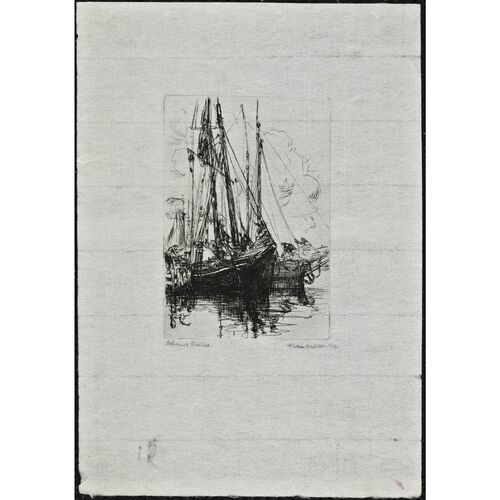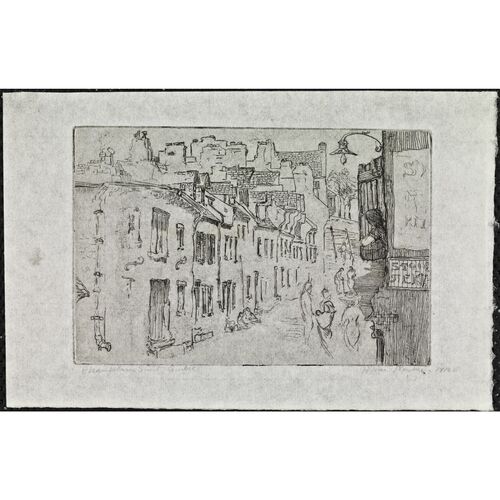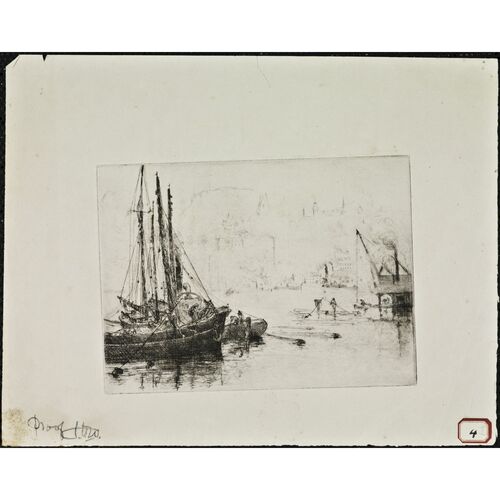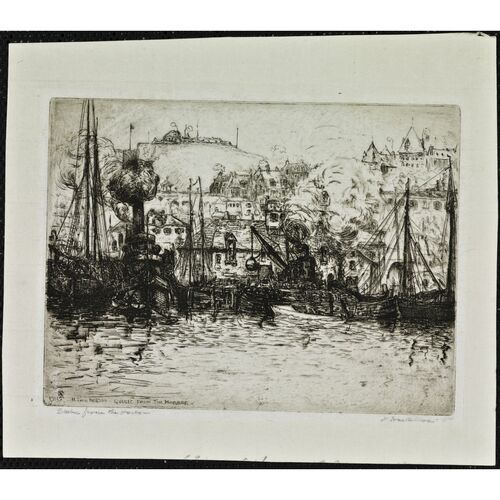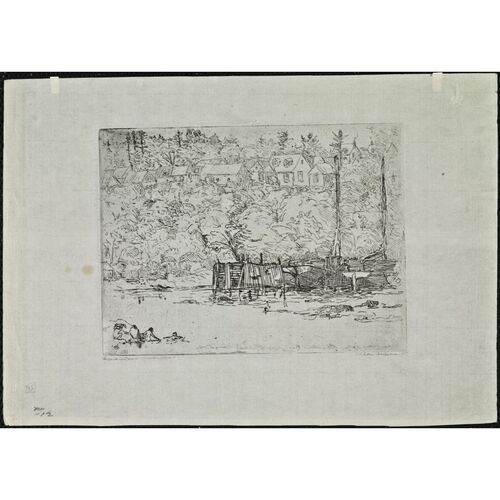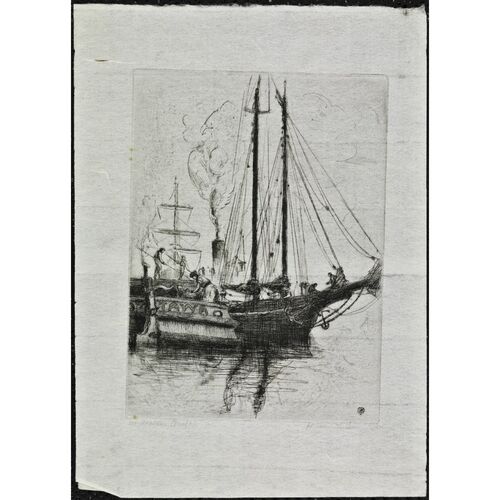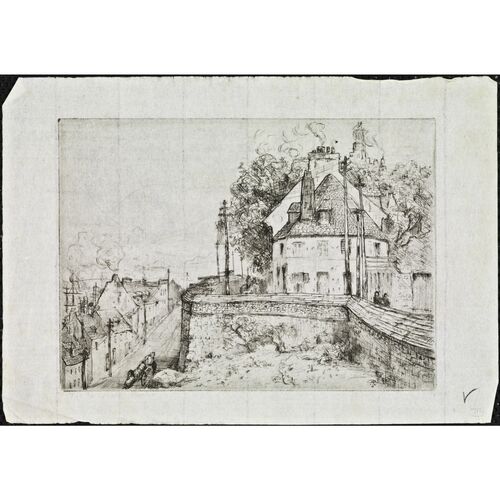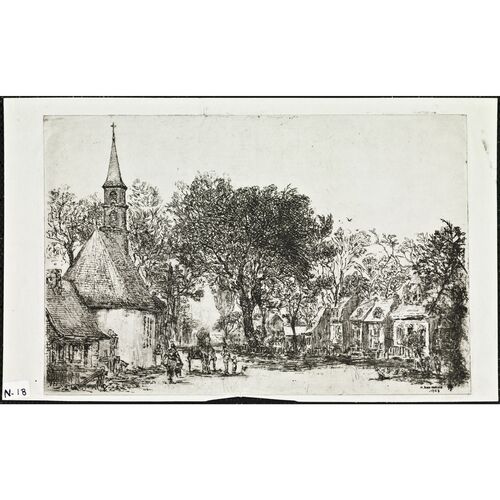Neilson, HENRY IVAN (before 1902 he occasionally signed Henry J. for Henry John), engineer, painter, etcher, and teacher; b. 27 June 1865 in Quebec City, 13th and youngest child of John Neilson, a dominion land surveyor, and Laura C. Moorhead; m. 12 Sept. 1911 Matilda Anne Green in Toronto, and they had two daughters and one son; d. 27 April 1931 in Quebec City.
Henry Ivan Neilson, called Harry by his family, was born into a distinguished Scottish and French Canadian family with important connections to the early history of printing in Lower Canada. In 1764 a great-great-uncle, William Brown*, had founded with Thomas Gilmore* one of the country’s first newspapers, the Quebec Gazette. Henry’s great-uncle Samuel Neilson* took over the paper and in 1792 started the Quebec Magazine, the first Quebec periodical illustrated with engravings. Samuel’s brother John*, who married a French Canadian, was Henry’s paternal grandfather; he carried on the Gazette and became a prominent politician.
After his education at the Petit Séminaire de Québec from 1875 to 1877 and at the Séminaire de Nicolet from 1877 to 1881, Henry participated in his father’s surveying expeditions along the Gander River, Nfld, in 1885 and the Little Mecatina River, Labrador, in 1886. Then he apprenticed as a mechanical engineer and joined the Canadian Pacific Railway Company in 1891. He was soon asked to go to sea to serve in the firm’s Pacific fleet; he also worked for a Caribbean tour operation. In 1895 he became a draughtsman for the Cooke Locomotive and Machinery Company and was subsequently appointed superintending engineer at the Barbour Flax Spinning Company, both in Paterson, N.J.
Sent to Scotland by his employer in 1896 to examine machinery, Neilson made the leap to an artistic career by attending the Glasgow School of Art for the 1896–97 term. During the following year he received some instruction at the Académie Delécluze in Paris; he then spent the 1898–99 season at the Académie des Beaux-Arts in Saint-Gilles, Belgium, where he attended the life classes of Jean-André-Alfred Cluysenaar. Between 1900 and late 1909 he lived in Kirkcudbright, Scotland, where an active artists’ colony, including members of the group known as the Glasgow Boys, gathered around painter Edward Atkinson Hornel. Neilson gradually adopted their freer brushwork, favouring, as they did, landscape and genre subjects. He participated in numerous exhibitions with the Society of Scottish Artists (member, 1902), the Scottish Arts Club (member, 1903), and the Royal Scottish Academy in Edinburgh, and with the Royal Glasgow Institute of the Fine Arts as well as further afield in Scotland and England. Many of these exhibitions were invitational and Neilson sometimes received flattering reviews which praised, in particular, his impetuous touch with brush and palette knife and his lively tone, but his paintings did not generally hang in important rooms. Among the works he valued the most were A spring day on the Solway (c. 1903) and The goat herd (1904). Although he was represented by well-established dealers in Scotland and England, and clearly succeeded in selling his paintings, his reputation in this medium has not endured.
In 1906 Neilson spent the spring in Quebec, held his first one-man show in Montreal to enthusiastic reviews, and exhibited with the Royal Canadian Academy of Arts in Ottawa. In 1908, while studying for several months in Edinburgh, he was introduced to etching by Ernest Stephen Lumsden, who would establish a printmaking workshop at the new Edinburgh College of Art later that year. Neilson appears to have made only two etchings in Scotland, but his enthusiasm was such that when he returned to Quebec in October 1909 he brought an etching press with him.
Neilson quickly made contact with artists’ organizations in the province, and in 1911 he was a founder and the first president of the Society of Quebec Artists. After their marriage that year, he and his wife settled in Valcartier. Although he would offer paintings and prints for sale at the Château Frontenac and two other commercial venues in Quebec City, he viewed Toronto, his wife’s former home, as a market of potential importance and he spent the winters of 1913–14 and 1919–20 there, exhibiting either in his rented studio or at the Mackenzie and Company Art Gallery. In 1914 he and his wife moved to Cap-Rouge, a village west of Quebec City. The following year Neilson joined the Canadian Art Club and the Arts Club of Montreal, and he became an associate of the RCA. He would exhibit regularly with the academy from 1911 until 1928. A sociable and public-spirited man, he organized the Quebec leg of the artists’ exhibition that toured the country in 1915 in support of the Canadian Patriotic Fund. Two of his paintings, An October pastorale, Cap Rouge, Quebec (1915) and Spring’s garland (1918), were sold to the National Gallery of Canada.
Encouraged by reviewers and curators, Neilson spent more time on etching, which he had resumed in 1910. The establishment of a graphics section at the Canadian National Exhibition in Toronto in 1909 and a series of shows at the Art Museum of Toronto between 1914 and 1917 pointed to a resurgence of interest in the medium. Neilson’s prints, like his paintings, depicted both quiet Quebec byways and the teeming life of the St Lawrence River. Drawn on copper plates, usually executed on location, some of his etchings displayed the reticence of the British school, but others showed a rapid and rugged technique that gave an impression of motion and vitality akin to the liveliness in his brushwork. The Toronto Daily Mail and Empire, commenting on his work in 1919, noted that “there are the crowded harbor scenes, which contain plenty of virility. Industrial views are always treated by Mr. Neilson with the necessary amount of vigor and he gives satisfying interpretations of that side of modern Canadian life. On the other hand, nothing could be more exquisite or more delicately poetic than ‘A French-Canadian Village.’” Neilson’s experience as a mariner and his profound love of nature merge eloquently in the approximately 73 prints he is known to have produced. At a time when popular taste favoured picturesque European views, he represented Quebec urban and country scenes. Although a few other artists had occasionally taken up these subjects, Neilson was the first etcher in the province to do so on a regular basis. He declared to journalist and art lover Jules-Siméon LeSage that “he had not found such pretty spots of nature to paint in Europe.”
With his technical proficiency, his familiarity with international movements, and his press (full-scale etching presses were not otherwise available for educational purposes), Neilson was a natural choice as an instructor when the School of Fine Arts of Quebec was established in 1921. He taught drawing, sketching in colour, etching, and anatomy. Still under the purist influence of Lumsden, in 1928 he stated proudly to a reporter from the Chronicle-Telegraph (Quebec), “This is the only school in Canada … where [etching] is taught as it is taught in Europe, in that the whole process is carried out by the student, even to the mixing of the inks and the printing.” His courses can be considered the first formal training in printmaking in the country. Among his pupils, Omer Parent, Alfred Pellan*, Simone Hudon, and Albert Rousseau* are best known.
Although his new responsibilities reduced his artistic output, Neilson created some of his best prints, such as Chapelle de procession à Saint-Pierre-de-l’Île-d’Orléans (1927) and Old saw mill, Petite Rivière (1931), during his years at the school. He was named its principal in 1929. Initially the only Canadian on staff, as director he would be credited with introducing a shift away from French academic standards in favour of a student-based, informal style of teaching that was considered better suited to the character and aspirations of French Canadian students.
Eight months after the completion of an enormous painting, Conseil souverain (1926–30), for the Legislative Council, Neilson died. He and Charles Maillard*, director of the School of Fine Arts of Montreal, had been asked to supervise the task after the death of artist Charles Huot*. Exhausted by this task and his duties as principal, Neilson succumbed to respiratory problems which had developed, in part, from the chemicals used in the etching process.
Neilson’s immersion in one of the more modern British art movements had provided him with a broad perspective that enabled him to make significant contributions as an artist and educator in Canada. He was central to the establishment of formal art training in Quebec, and he left one of the earliest and most important collections of original prints representing life along the St Lawrence River.
Valuable information has been provided by Helen Ridout Neilson, the daughter of Henry Ivan Neilson. An interview with her appears in L. M. Fortin, “Le rôle d’Henry Ivan Neilson, artiste/graveur/enseignant, dans l’évolution de la gravure au Québec” (mémoire de ma, Concordia Univ., Montréal, 1996).
BANQ-Q, E4, 1960-01-483/628; P192. Univ. Laval, Div. des arch. (Québec), P433/D1, 1 (fonds École des Beaux-Arts de Québec), “Historique de l’École des beaux-arts” (attribué à J.‑B. Soucy, 1938?). Chronicle-Telegraph (Quebec City), 18 Oct. 1928. Daily Mail and Empire, 17 May 1919. Canadian encyclopedia, 3: 1483–85. Canadian men and women of the time (Morgan; 1912). J. L. Caw, Scottish painting past and present, 1620–1908 (Edinburgh, [1908?]). Alphonse Désilets, “Les beaux-arts à Québec,” Le Terroir (Québec), [12] (1930–31), nos.2–3: 27, 29. Jan Johnson, “Henry Ivan Neilson (Québec, 1865–1931),” in Printmaking in Québec, 1900–1950, trans. Multiscript/La langagerie (exhibition catalogue, Musée du Québec, 1990), 110–13. J.‑S. LeSage, Notes et esquisses québécoises: carnet d’un amateur (Québec, 1925).
Cite This Article
Jan Johnson, “NEILSON, HENRY IVAN (Henry J.),” in Dictionary of Canadian Biography, vol. 16, University of Toronto/Université Laval, 2003–, accessed January 20, 2025, https://www.biographi.ca/en/bio/neilson_henry_ivan_16E.html.
The citation above shows the format for footnotes and endnotes according to the Chicago manual of style (16th edition). Information to be used in other citation formats:
| Permalink: | https://www.biographi.ca/en/bio/neilson_henry_ivan_16E.html |
| Author of Article: | Jan Johnson |
| Title of Article: | NEILSON, HENRY IVAN (Henry J.) |
| Publication Name: | Dictionary of Canadian Biography, vol. 16 |
| Publisher: | University of Toronto/Université Laval |
| Year of revision: | 2014 |
| Access Date: | January 20, 2025 |


![Champlain Street, Quebec [image fixe] / H. Ivan Neilson NAE Original title: Champlain Street, Quebec [image fixe] / H. Ivan Neilson NAE](/bioimages/w600.2062.jpg)
